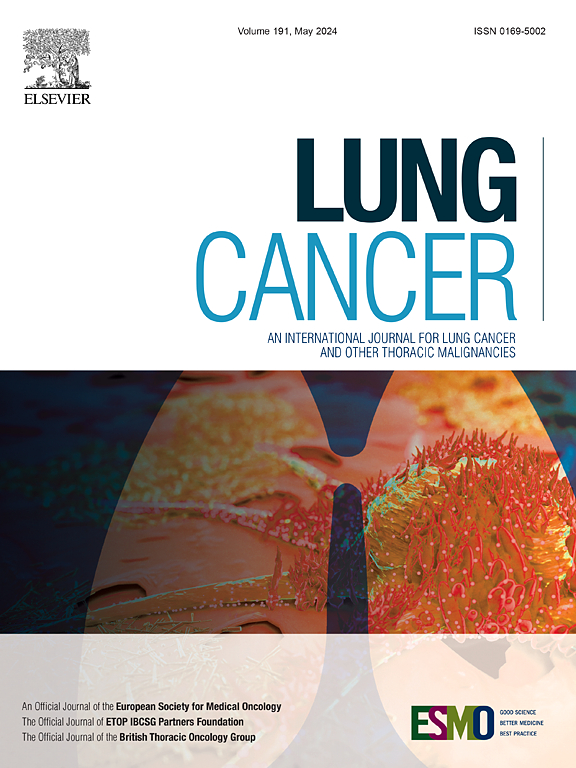转化小细胞肺癌与原发小细胞肺癌的临床结果和神经内分泌特征
IF 4.4
2区 医学
Q1 ONCOLOGY
引用次数: 0
摘要
转化小细胞肺癌(T-SCLC)的临床结果以前被认为与原发性SCLC (P-SCLC)相当。然而,t - sclc和p - sclc在免疫治疗时代是否存在差异尚不清楚。方法回顾性分析临床结果。采用Kaplan-Meier法和Cox回归估计总生存期(OS)。采用线性相关和回归分析评估基线神经元特异性烯醇化酶(NSE)的预后价值。采用分层聚类法对T-SCLC的神经内分泌(NE)标志物进行免疫组化分组。结果2018年3月至2023年3月期间,206例T-SCLC (n = 42)和P-SCLC (n = 164)纳入了该研究。T-SCLC组的中位OS (mOS)明显短于P- sclc组(11.7个月vs 12.9个月,P = 0.033)。在T-SCLC队列中,化疗免疫治疗的生存期明显长于化疗(15.4个月vs 8.5个月,P = 0.001)。最佳基线NSE临界值在T-SCLC (19.7 ng/ml)和P- sclc (74.8 ng/ml)之间存在差异,高NSE水平与T-SCLC (10.0 vs. 16.5个月,P = 0.003)和P- sclc (10.8 vs. 16.5个月,P <;0.001)。在T-SCLC中,NE标记物表达较强的组存活时间较长(14.3个月比10.3个月,P = 0.030)。结论t - sclc预后较P-SCLC差,但差异不大。化疗免疫治疗可能改善T-SCLC的预后。表现出较强神经内分泌特征的T-SCLC患者可能预后较差。本文章由计算机程序翻译,如有差异,请以英文原文为准。
Clinical outcomes and neuroendocrine features of transformed versus primary small-cell lung cancer
Introduction
The clinical outcomes of transformed small-cell lung cancer (T-SCLC) was previously considered comparable with primary SCLC (P-SCLC). However, whether T-SCLCs and P-SCLCs differ in the era of immunotherapy remains unclear.
Methods
Clinical outcomes were retrospectively analyzed. Overall survival (OS) was estimated using the Kaplan–Meier method and Cox regression. Linear correlation and regression analyses were used to assess prognostic value of baseline neuron-specific enolase (NSE). Hierarchical clustering was used to group neuroendocrine (NE) markers of T-SCLC by immunohistochemical results.
Results
Between March 2018 and March 2023, 206 patients with T-SCLC (n = 42) and P-SCLC (n = 164) were enrolled in the study. The median OS (mOS) of T-SCLC cohort was significantly shorter than that of the P-SCLC cohort (11.7 vs. 12.9 months, P = 0.033). In the T-SCLC cohort, the mOS of chemoimmunotherapy significantly outlasted that of chemotherapy (15.4 vs. 8.5 months, P = 0.001). The optimal baseline NSE cutoff values differed between T-SCLC (19.7 ng/ml) and P-SCLC (74.8 ng/ml), and a high NSE level was associated with poorer mOS in both T-SCLC (10.0 vs. 16.5 months, P = 0.003) and P-SCLC (10.8 vs. 16.5 months, P < 0.001). The cluster with stronger expression of NE markers in T-SCLC exhibited longer mOS (14.3 vs. 10.3 months, P = 0.030).
Conclusion
T-SCLC had a statistically poorer prognosis than P-SCLC, but the difference was modest. Chemoimmunotherapy might improve the outcomes of T-SCLC. Patients with T-SCLC who show stronger neuroendocrine features may have a poorer prognosis.
求助全文
通过发布文献求助,成功后即可免费获取论文全文。
去求助
来源期刊

Lung Cancer
医学-呼吸系统
CiteScore
9.40
自引率
3.80%
发文量
407
审稿时长
25 days
期刊介绍:
Lung Cancer is an international publication covering the clinical, translational and basic science of malignancies of the lung and chest region.Original research articles, early reports, review articles, editorials and correspondence covering the prevention, epidemiology and etiology, basic biology, pathology, clinical assessment, surgery, chemotherapy, radiotherapy, combined treatment modalities, other treatment modalities and outcomes of lung cancer are welcome.
 求助内容:
求助内容: 应助结果提醒方式:
应助结果提醒方式:


